About Bac Ninh Cathedral
Bac Ninh Cathedral is located at Ngo Gia Tu Street, Ninh Xa, Bac Ninh Province. The church is located in a prime location right in the center and only 300m from the ancient citadel of Bac Ninh. In 1889, Bishop Antonio Le – the first bishop chose to buy the land here and started building the church together with the Bishop’s House. After 3 years of construction, in 1892 Bac Ninh Cathedral was officially inaugurated. Since then, this is the place where people gather for regular religious activities in Bac Ninh and surrounding areas.
 Bac Ninh Cathedral
Bac Ninh Cathedral
During the fierce war years, many historical buildings were severely damaged. However, after more than a hundred years of ups and downs, Bac Ninh Cathedral still stands firm, overcomes the bombs and moss of the years and becomes a symbol of Kinh Bac diocese, a “heritage of faith”. preserve the eloquent historical evidences of the nation. Thanks to that, despite many difficulties in the life of faith, the iron faith of Bac Ninh diocese remains steadfast and unwavering.
 An old photo of the old Bac Ninh Cathedral remains
An old photo of the old Bac Ninh Cathedral remains
The unique architecture of Bac Ninh Cathedral
Bac Ninh Cathedral was built in the unique Italian Baroque style, formed in the 16th century. The space of the church is built according to the cross-shaped structure and follows the typical symmetry rule of the church architecture of the Renaissance period. The church is about 45m long, 12m wide, made up of 12 main rectangular columns, two stories high, representing the 12 apostles, divided equally into two rows, six on each side.
 Bac Ninh Cathedral is bold with unique Italian Baroque architecture
Bac Ninh Cathedral is bold with unique Italian Baroque architecture
From a distance, you will be extremely impressed with the exterior appearance of Bac Ninh Cathedral . The first highlight is the church facade with two 22m high towers. This tower is made up of 4 stacked cubes and on top is the spire. There is an opinion that these two towers represent the brother and sister standing holding a sports hat. Inside the two spiers hang three bronze bells cast since the construction of the church. For more than a century, the familiar high-pitched bell of the Bac Ninh church has been ringing steadily throughout the streets. That bell has become an indispensable part of religious life in particular and in the homeland of Quan Ho in general.
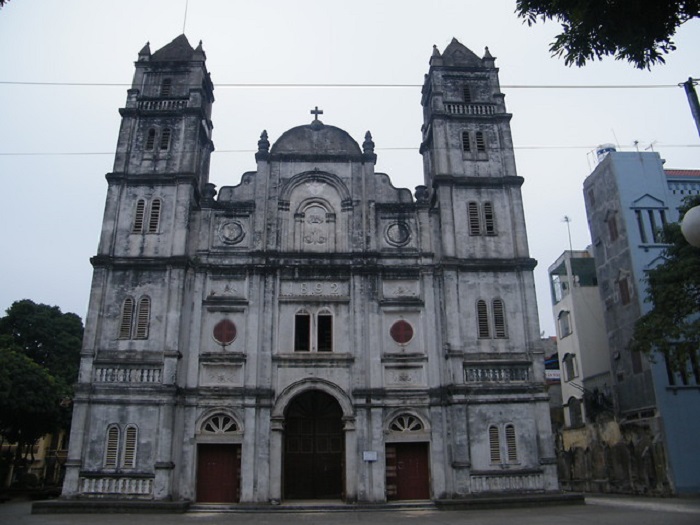 The architecture of the facade of the church
The architecture of the facade of the church
In front of the church, we can easily recognize many symbolic images of Our Lady. At the top is the symbol of Mother Tam with a heart combined with a crown. Right below that is an image of a crown and four flowers representing Our Lady of the Rosary. The two sides are carved with two episcopal coats of arms believed to belong to Bishop Anthony Colossae Mass and Bishop Macsimino Vanlatco Kham. Below are four additional roses engraved on the occasion of the church’s 100th anniversary, symbolizing devotion to Our Lady. Under the church hall, there are three entrance doors, a large door in the front and two small side doors on either side. This is quite similar to the Tam Quan village gate in Vietnamese villages.
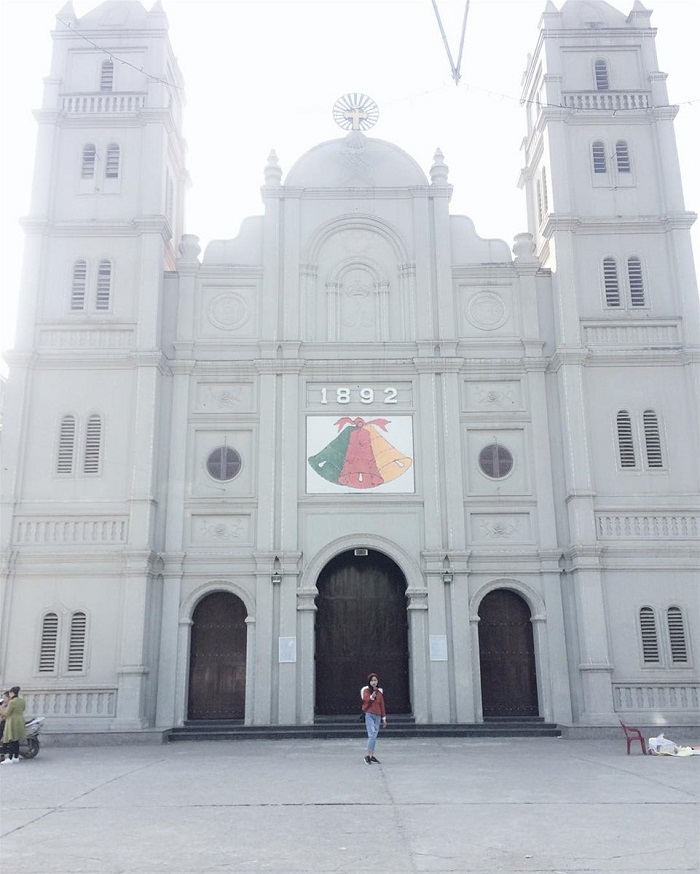 Bac Ninh Cathedral includes three entrances, one main aisle and two side aisles
Bac Ninh Cathedral includes three entrances, one main aisle and two side aisles
Going inside the church, you will probably be even more impressed with the space here. A large, airy space filled with shimmering light every morning when the morning sun shines down. The sanctuary is the center of the church with a very unique and delicate design with thousands of pieces of red incense wood interspersed. The roof of the church is built of maple wood in the style of latticework. On both sides are glass paintings depicting the portraits of 4 Evangelists and depicting 20 mysteries of the Rosary. The highlight of the sanctuary is the cross made of large red cedar wood and the statue of “Crucified” carved in monolithic Pomu wood. Above the altar are 12 reliefs depicting the first 12 parish churches established when the new diocese was born in 1883.
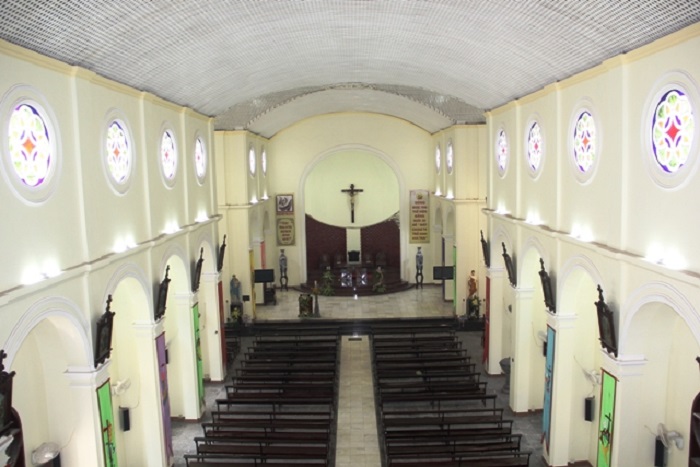 The entire space inside the sanctuary
The entire space inside the sanctuary
At the end of the church is the Cathedral – where the Bishop’s throne is located, representing the presence and rule of the Diocesan Ordinary. The Holy Table, Chair and podium are all made from delicately carved red incense, symbolizing the harmony between heaven and earth and the eternal permanence of Christianity.
To the left of the sanctuary is the oldest statue of the Holy Rosary Queen of the Diocese. According to recorded documents, this statue was given to the church by the Spanish Dominican Fathers on the occasion of its inauguration in 1892. The soft and gentle appearance makes the statue more alive and bold with the breath of life. Live the Faith. Opposite to the right side of the sanctuary is the statue of Saint Joseph Hoang Luong Canh, holding a branch of the sage in his hand. During the reign of King Minh Mang, he courageously maintained the Faith by affirming “God is the patriarch” and was martyred on September 5, 1838 at Co Me’s execution ground. On May 27, 1900, Pope Leo XIII honored him as Blessed of the Church. On June 19, 1988, Pope John Paul II exalted him to the rank of Saint.
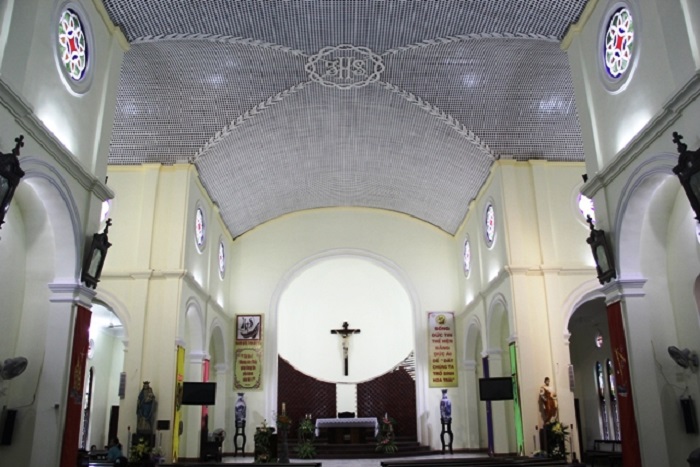 The Cathedral area with the highlight is a large cross made of oak wood
The Cathedral area with the highlight is a large cross made of oak wood
Bac Ninh Cathedral – a destination not to be missed
Bac Ninh Cathedral has undergone a restoration in 1990, but it still retains its inherent ancient architecture. Today, this place is the site of regular religious activities of parishioners. Every Sunday, everyone goes to church and prays. Today, this place has become a destination for many parishioners in the area as well as tourists and young people to visit and explore.
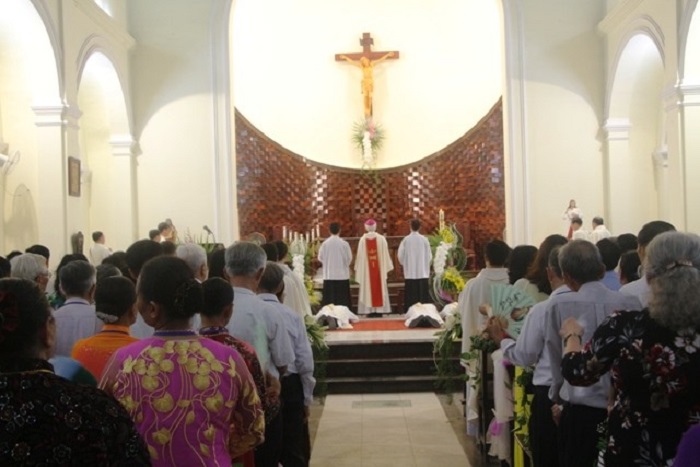 A session at Bac Ninh Cathedral
A session at Bac Ninh Cathedral

Source: Collected internet.